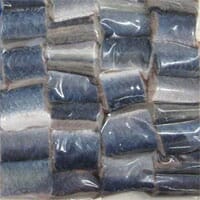Report Highlights
A visit to the International Fisheries Expo 2007 in Xiamen highlighted South China’s pivotal role, especially Fujian Province’s, in processing seafood. Fujian and Guangdong each process about the same amount and rank second after Shandong Province where most seafood in China is processed. Last year Fujian exported 1.3 million tons, worth US$1.5 billion. It is also China’s largest processor of eel, with exports valued $.7 billion. Fujian ranks first in per capita annual seafood expenditure. Food safety scares are hot issues, and many local processors are worried about its impact on business. In 2006, China imported $.4 billion from the States. In 2006, China imported $ 3.2 billion from all sources, mostly from Russia, the United States and Japan. Of this perhaps over 40 percent was re-exported.
 |
| The opening ceremony attracted many governmental officials and press |
ATO/GZ director and staff visited the International Fisheries Expo 2007 in the city of Xiamen (located in Fujian Province) organized by the Marine and Fishery Bureau of Fujian Province, Fujian Fishery processing and Circulation Association, and the Fujian Province Eel Industry Association. About 214 booths were sold, and 80 exhibitors were present. There was an opening ceremony with many media and company reps from the Pan-Pearl River region from Guangdong, Jiangxi, Dalian, Taiwan, Hong Kong Agriculture, fisheries and Conservation Department, and Maritime administration of Macao Special Administrative Region. Some exhibitors thought this year’s exposition was better organized, but others were disappointed by the lack of international buyers. Many said that they would consider attending the “Aquaculture China & China Fisheries & Seafood Expo” in Dalian this November.
After the ceremony, ATO/director met with Mr. Chen, the director of the Fujian Marine and Fishery Bureau as well as director of the Fujian Fishery Processing & Circulation Association and deputy director of China Fishery Circulation & Processing Association. The Fujian Fishery Processing and Circulation Association has 270 member companies, of which 140 are processors. The rest are materials suppliers or involved in education, service or testing. Meanwhile, post also learned that in China, Shandong Province processes the most seafood, followed by Guangdong/Fujian Province (about equal) and Zhejian Province. Processed seafood is mainly for export. The annual aquaculture export volume from Fujian is 1.3 million tons, valued US$1.5 billion.
Post met a representative for Dalian Zhangzidao Fishery Group Co., Ltd, which has a jointbreeding program in Fujian. Interestingly, each year, during the winter, trucks of live scallops are sent from Dalian to Xiamen to take advantage of warmer waters. This helps them grow much faster. Then, they return to Dalian before summer. Thus, scallop production increases dramatically, and taste as well as quality are ensured.
 |
| Frozen cut eel |
According to one official, there are limited amounts of frozen abalone and lobster from Australia; frozen salmon and lobster from Canada; and frozen salmon from Norway available in Fujian at high-end restaurant and hotels. From time to time, there are product promotions and cooking demonstrations conducted. However, few Fujian consumers are aware of U.S. seafood items due to lack of promotion. He emphasized that such products only have a small niche since there is an abundance of local seafood available. It’s no surprise that Fujianese consume the most seafood in China.
Medium- and low-level U.S. seafood, such as Pink and Chum salmon, cod and Pollock account for most exports to China, normally for further processing, then re-export to the States, Europe and Japan. That leaves high quality products such as King Salmon, Sockeye Salmon, King Crab, Black Cod and halibut that are consumed in China and sold in high-end restaurants and hotels.
According to a rep from the Eel Industry Association of Fujian, Fujian is the largest processor of eel in China, with exports valued $.7 billion, mostly to Japan and a limited amount to Asian communities in the States and Canada. Most processors (about 140) who are members of the Fujian Fishery Processing and Circulation Association (mentioned previously) are also members of the Eel Industry Association. Before processing, Fujian produces 90,000 tons a year.
By contrast, live eels are mostly sourced from Guangdong Province for Chinese and Japanese restaurants in China. Eels like the warmer waters of Fujian, Guangdong and Taiwan. Originally, the bulk of eels were processed in Japan, then in Taiwan, then in China. Shandong Province exports a substantial amount of abalone and sea bass. Many processed items such as eels, prawns, yellow croaker, tuna, scallops and tilapia are exported to Japan, Korea, Australia, Russia, Canada and United States. The booth belonging to the Fujian Provincial Fishery Technical Extension Center is a state-owned public institution under the Fujian Provincial Marine & Fisheries Bureau which is involved in extension work as well as aquaculture disease control. In order to fight outbreaks and epidemics of aquatic organisms, an aquatic organism disease monitoring project has been launched in Fujian.
Food safety is a hot issue in Fujian. It is reported that several types of farm-raised fish and shellfish have been found to contain significant amounts of carcinogens and contamination; Officially, the U.S. Food and Drug Administration has issued an “alert”, though not an outright ban, on farm-raised catfish, shrimp, dace and eel from China. According to FDA, certain Chinese aquaculture products exported into the United States contain illegal substances that are not permitted in seafood sold in the United States; this includes unapproved veterinary drugs such as malachite green and crystal violet. Therefore, Chinese firms need to comply with FDA requirements and safety standards before exporting seafood to the United States. Many exhibitors at the show expressed concerns about future seafood business with the United States.
Aquatic trade between China and the United States is forecast to grow in 2007, with “Fish/Frozen” continuing to be the major category imported from the United States, while the export mix to the United States is diversified and value added. In CY 2006, China’s imported US$0.4 billion worth of seafood. From January to July, 2007, sales were $0.3 billion with a growth rate at 19.5%.
There is no official data on the share of processed goods of total import volume . Industry insiders believe the current export value of processed goods could exceed 40 percent of total exports from all sources. (For more details, please refer to GAIN Report CH6122.)
Further Reading
To view our complete list of 2007 Fishery Products Annual reports, please click hereSeptember 2007

